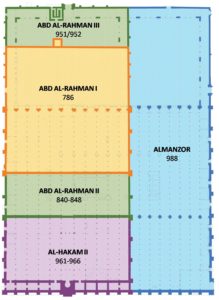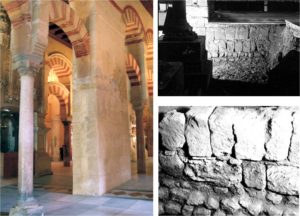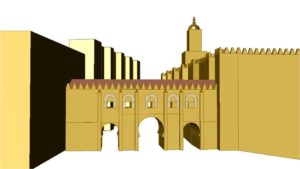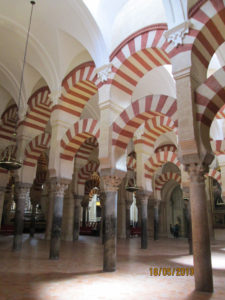
The Great Mosque

The construction of the Great Mosque in Cordoba began around 786 on the orders of the first Umayyad emir Abd al-Raḥmān I. The majority of the scholars defend that the building was erected on the remains of the old Episcopal See of San Vicente. In this primitive mosque, pieces of Roman and Visigothic structures were reused. The naves were separated by double arcades: the upper ones were composed by semicircular arches and the lower ones by horseshoe arches, in which were combined voussoir of calcarenite stone and brick. This solution gave height and firmness to the construction and was maintained in later enlargements. Years later, Ḥišām I completed the work of his predecessor with a minaret in the courtyard, a pavilion for women and a ablutions space.

The first expansion of the Great Mosque was undertaken between the years 840 and 848 by ‘Abd al-Raḥmān II. Then, the prayer room enlarged to the south. Muḥammad I was in charge of, among other actions, culminating the ornamentation of this expansion in the middle of the 9th century. At the end of the same century, the emir ‘Abd Allāh built a raised passageway (sābāṭ) to connect the prayer room with the Citadel (Alcazar). This structure would be demolished decades later.

In caliphal times, ‘Abd al-Raḥmān III started the works to enlarge the courtyard to the north (951-952) and to construct a new minaret. His son, al-Ḥakam II, carried out the second extension of the prayer room to the south (961-966), in which only new architectural pieces were used. He also built a new sābāṭ and the present wall of the qibla, the miḥrāb and the maqsura.

Finally, the last extension of the Cordoban Mosque took place in the year 988. Almanzor, prime minister of the caliph Ḥišām II, was its main person in charge. Both the courtyard and the prayer room almost doubled their size to their eastern side.
Bibliography
AMADOR DE LOS RÍOS, R. (1879): Inscripciones árabes de Córdoba: precedidas de un estudio histórico-crítico de la Mezquita-Aljama, Madrid.
ARJONA, A.; MARFIL, P. (2000): “Nuevos hallazgos arqueológicos en el entorno de la Mezquita: excavaciones en Ronda de Isasa nº 2 (Córdoba) y del Balat al-Hurr a la Casa de los Rehenes de la Córdoba Islámica, B.R.A.C. nº 139, pp. 115-136.
BRISCH, K. (1965): “Zum Bāb al Wuzarā’ (Puerta de San Esteban) der Hauptmoschee von Córdoba”, en Studies in Islamic Art and Architecture in honour of Professor K. A. C. Creswell, El Cairo, pp. 30-48.
CALVO, S. (2001): “El programa epigráfico de la Mezquita de Córdoba en el siglo X: un alegato en favor de la doctrina malikí”, Qurtuba nº 5, pp. 17-26.
CALVO, S. (2008): “La ampliación califal de la mezquita de Córdoba: mensajes, formas y funciones”, Goya Revista de Arte nº 323, pp. 89-106.
CRESSIER, P. (1984): “Les chapiteaux de la grande mosquée de Cordoue (oratoires d’ ‘Abd al-Rahmān I et d’ ‘Abd al-Rahmān II) et la sculpture de chapiteaux à l’époque émirale: première partie”, Madrider Mitteilungen nº 25, pp. 216-281.
CRESSIER, P. (1985): “Les chapiteaux de la grande mosquée de Cordoue (oratoires d’ ‘Abd al-Rahmān I et d’ ‘Abd al-Rahmān II) et la sculpture de chapiteaux à l’époque émirale: deuxième partie”, Madrider Mitteilungen nº 26, pp. 257-313.
DODDS, J. (1992): “La gran mezquita de Córdoba”, en DODDS, J. (Ed.): al-Andalus: las artes islámicas en España, Madrid-Nueva York, pp. 10-25.
EWERT, C. (1987): “Tipología de la mezquita en Occidente: de los Omeyas a los Almohades”, en Arqueología Medieval Española, Congreso Madrid 19-24 enero 1987, tomo I: Ponencias, pp. 180-204.
FAIRCHILD, D. (2011): “La estratigrafía del olvido: la gran mezquita de Córdoba y su legado refutado”, Antípoda nº 12, pp. 19-37.
FERNÁNDEZ PUERTAS, A. (2000): “Mezquita de Córdoba. Trazado proporcional de su planta general (siglos VIII-X), AEspA nº 73, pp. 217-248.
FERNÁNDEZ PUERTAS, A. (2008): “Mezquita de Córdoba: Abd al-Rahman I (169/785-786). El trazado proporcional de la planta y alzado de las arquerías del oratorio. La quibla y el mihrab del siglo VIII”, AEspA nº 324, pp. 333-356.
FERNÁNDEZ PUERTAS, A. (2009a): Mezquita de Córdoba: su estudio arqueológico en el siglo XX, Granada.
FERNÁNDEZ PUERTAS, A. (2009b): “Mezquita de Córdoba: el trazado de la portada interior de la Bab al-Wuzara’. La Puerta de los Deanes (s. VIII), su trazado interior y exterior”, AEspA nº 326, 2009, pp. 107-136.
GARCÍA GÓMEZ, E. (1952): “Una descripción desconocida del alminar de la mezquita de Córdoba”, al-Andalus nº 17-II, pp. 399-400.
GIESE-VÖGELI, F. (2007): “Die Gewölbe der Grossen Moschee von Córdoba und der islamische Osten. Ursprung, Verbreitung und Auflösung eines Wölbsystems, mit 6 Testabbildungen und den Taflen 28-32”, Madrider Mitteilungen nº 48, pp. 306-322.
GIESE-VÖGELI, F. (2008): “La mezquita mayor de Córdoba y Samarra”, A.A.C. nº19, pp. 277-292.
HERNÁNDEZ GIMÉNEZ, F. (1961-62): “El codo en la historiografía árabe de la mezquita mayor de Córdoba: contribución al estudio del monumento”, al-Mulk nº 2, pp. 5-52.
HERNÁNDEZ GIMÉNEZ, F. (1975): El alminar de Abd al-Rahman III en la Mezquita Mayor de Córdoba: génesis y repercusiones, Granada.
KHOURY, N. (1996): “The meaning of the Great Mosque of Cordoba in the tenth century”, Muqarnas nº 13, pp. 80-98.
MARÇAIS, G. (1965): Sur les mosaiques de la grande mosquée de Cordoue, El Cairo.
MARFIL, P. (2004): “Estudio de las linternas y el extradós de las cúpulas de la maqsura de la Catedral de Córdoba, antigua Mezquita Aljama”, Arqueología de la Arquitectura nº 3, pp. 91-107.
MARFIL, P. (2009): La puerta de los visires de la mezquita omeya de Córdoba, 2 vols., Córdoba.
MARFIL, P. (2010): Las puertas de la Mezquita de Córdoba durante el Emirato omeya, Tesis Doctoral, Universidad de Córdoba.
MONTEJO, A. (1999): “El pabellón de abluciones oriental de la Mezquita Aljama de Córdoba correspondiente a la ampliación de Almanzor”, Cuadernos de Madinat al-Zahra nº 4, pp. 209-231.
NIETO, M. (1998): La Mezquita-Catedral de Córdoba, Barcelona.
NIETO CUMPLIDO, M. (1998), La Catedral de Córdoba, Córdoba.
NIETO, M. y LUCA DE TENA, C. (1992), La Mezquita de Córdoba: planos y dibujos, Córdoba
OCAÑA JIMÉNEZ, M. (1942), “La basílica de San Vicente y la gran Mezquita de Córdoba”, Al Andalus, 7, Madrid, pp. 347-366.
OCAÑA, M. (1988-1990): “Inscripciones árabes fundacionales de la Mezquita-Catedral de Córdoba”, Cuadernos de Madinat al-Zahra nº 2, pp. 9-28.
SOUTO LASALA, J. A. (2009): La mezquita aljama de Córdoba. De cómo al-Andalus se hizo edificio, Instituto de Estudios Islámicos y del Próximo Oriente, Zaragoza.

